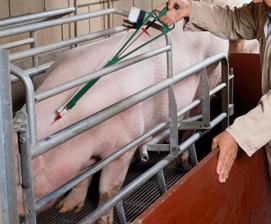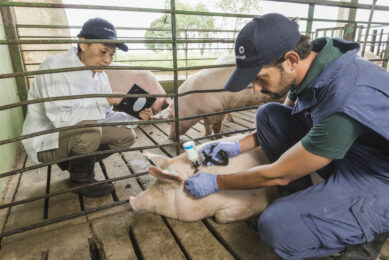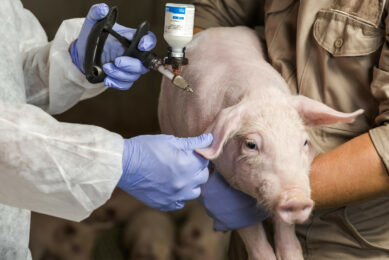Simultaneous vaccination: The road to working efficiently

Swine vaccination is a practice which absorbs a lot of costs and time. Since time is money in pig management, simultaneous vaccination would simply help step up the efficacy in pig production and also increase animal welfare. Numerous publications at congresses are being dedicated to uncover more details about combination possibilities.
By Vincent ter Beek
Simultaneous vaccination is a practice when organisms are being vaccinated for several diseases using only one treatment. In humans, this has become a fairly common principle, as for instance a DPT combined vaccine is given to children older than two months, combining vaccines against diphtheria, pertussis and tetanus. For domestic animals, like dogs or cats, research into vaccination possibilities has also progressed far.
©
In livestock, simultaneous vaccination could imply a serious improvement of efficiency and animal welfare.
©
These developments, however, did not happen overnight, as there are several reasons why using several vaccines simultaneously should be considered minutely prior to actually applying them. The main reason is that it is sometimes not significantly proven that two vaccines can be given at exactly the same moment. Unless properly trialled and researched, antigens or adjuvants may prove to be conflicting and lead to unexpected complications or on the contrary, annihilation of any vaccine’s functioning.
©
Vaccinating livestock
In livestock, simultaneous vaccination could imply a serious improvement of efficiency and hence a decrease of costs. From the field, therefore, a strong demand exists to reach advice as to what vaccine combinations may be logical. Some of them are obvious, like combinations of vaccines for Erysipelas and parvovirus or combining Escherichia coli (E.coli) and clostridium vaccinations. Others, however, may not be as obvious. In addition, more than in human or companion animal medicine, vaccination requirements are different on every farm as disease prevalence is also different.
©
For every possible vaccine combination, a range of trials need to be performed, with positive outcome, in order to take away any reason for registration authorities to believe that administering two vaccines at the same time does still work in the way it was projected. In short, the development of vaccinating simultaneously in livestock has progressed at a slower pace as in human medicine.
©
Trials in gilts
The least complicated way to address the demand for knowledge from the field is by proving that individual vaccine combinations can be perfectly administered simultaneously. The animal health industry and academic institutes have long been trying and testing different kinds of vaccines simultaneously in order to be able to answer practical questions from the market.
©
For instance, the efficacy of two different vaccines, against E.coli and Aujeszky’s Disease (AD), was recently tested when administered simultaneously in three groups of eight AD-free gilts.
©
Three groups of eight gilts were intramuscularly injected with either only the E.coli vaccine (group 1), a combination of E.coli and AD vaccines (group 2) and only AD vaccine (group 3). The researchers used three blood sampling moments, T0 being the moment of the first vaccination (AD and/or E.coli), T1 the moment of the second vaccination (T0 + four weeks; only E.coli) and T2 (T0 + six weeks). In vitro tests combining two vaccines’ adjuvants did not yield any negative results on any of the vaccines.
©
In addition, the trial report reads: “The data presented demonstrated that there is no loss of stability or efficacy in engendering more than adequate protective seroconversion when mixing and administering these two vaccines together.” (see Figure 1).
©
Seroconversion to all E.coli antigens was acceptable, the report continues, “with end titres above the average protective level (log2 serum antibody titre of 10 or above) and with no significant differences” between the groups vaccinated with the E.coli vaccine only or the with the combination of vaccine.
©
Similar adjuvants
Another solution to bridge the gap between the simultaneous use of various vaccines is to apply the same adjuvant in many vaccines, thus making them compatible by the way they are built up – and effectively use them in one injection. An example of recent research into this field used the Diluvac Forte adjuvant, for vaccines against E.coli and Erysipelas. Trials to establish the combination’s efficacy were carried out at the Ihan farms, Slovenia, by Dr. Stane Košorok.
©
Two groups of 40 pregnant sows and gilts (with a minimum of five gilts per group), inseminated in the same week, received vaccination against both diseases. They were vaccinated at week 7 and week 3 prior to expected farrowing – the second injection being a booster vaccination. On average six days before expected farrowing (approximately 15 days after the second vaccination) the blood samples were collected and sent to a laboratory in the Netherlands for antibody level detection and statistical evaluation of the obtained data.
©
One group received intramuscular injections for both the E.coli vaccine and the Erysipelas vaccine separately, each vaccine being 2 ml. The second group was intramuscularly injected with 4 ml of E.coli and Erysipelas vaccine mixed together in one bottle and syringe. Results yielded that “the application of the Erysipelas and E.coli vaccine together or separately does not differ in seroresponse”, see also Table 1.
©
Future research
The list of potential combinations is virtually endless. Are vaccine combinations for PRRS and Mycoplasma hyopneumoniae (M.hyo) compatible, what about Aujeszky’s Disease and Actinobacillus pleuropneumoniae (App) or M.hyo and Glässer’s Disease?
©
Some answers have already been found, other questions remain open. More desk and trial research will shed additional light on combination possibilities, both for breeding sows, but also for piglets and fatteners.
©
Source: Pig Progress Volume 25 nr©7











